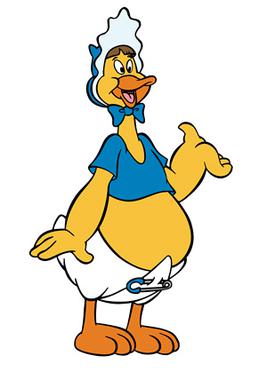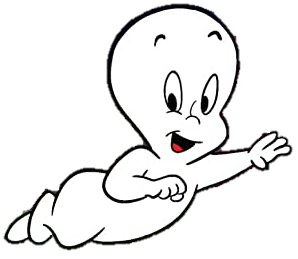
Olive Oyl is a cartoon character created by E. C. Segar in 1919 for his comic strip Thimble Theatre. The strip was later renamed Popeye after the sailor character that became the most popular member of the cast; however, Olive Oyl was a main character for a decade before Popeye's 1929 appearance.

Bluto, at times known as Brutus, is a cartoon and comics character created in 1932 by Elzie Crisler Segar as a one-time character, named "Bluto the Terrible", in his Thimble Theatre comic strip. Bluto made his first appearance on September 12 of that year. Fleischer Studios adapted him the next year (1933) to be the main antagonist of their theatrical Popeye animated cartoon series.

Famous Studios was the first animation division of the film studio Paramount Pictures from 1942 to 1967. Famous was established as a successor company to Fleischer Studios, after Paramount seized control of the aforementioned studio amid the departure of its founders, Max and Dave Fleischer, in 1942. The studio's productions included three series started by the Fleischers—Popeye the Sailor, Superman, and Screen Songs—as well as Little Audrey, Little Lulu, Casper the Friendly Ghost, Honey Halfwitch, Herman and Katnip, Baby Huey, and the Noveltoons and Modern Madcaps series.

Baby Huey is a gigantic and naïve duckling cartoon character. He was created by Martin Taras for Paramount Pictures' Famous Studios, and became a Paramount cartoon star during the 1950s. Huey first appeared in Quack-a-Doodle-Doo, a Noveltoon theatrical short produced and released in 1950.

Mae Questel was an American actress. She was best known for providing the voices for the animated characters Betty Boop, Olive Oyl and numerous others.
Volodymyr Peter "Bill" Tytla was a Ukrainian-American animator known for his work in Walt Disney Animation Studios, Paramount's Famous Studios, and Terrytoons. In his Disney career, Tytla is particularly noted for the animation of Snow White and the Seven Dwarfs, Pinocchio, Fantasia and Dumbo. He was inducted as a Disney Legend in 1998.

Harvey Comics was an American comic book publisher, founded in New York City by Alfred Harvey in 1941, after buying out the small publisher Brookwood Publications. His brothers, Robert B. and Leon Harvey, joined shortly after. The company soon got into licensed characters, which, by the 1950s, became the bulk of their output. The artist Warren Kremer was closely associated with the publisher.

Noveltoons is a series of cartoons produced by Paramount Pictures' Famous Studios from 1943 to the end of the studio during 1967. The series was known for bringing the characters from Harvey Comics to life, such as Casper the Friendly Ghost, Wendy the Good Little Witch, Herman and Katnip, Little Audrey, and Baby Huey. All shorts from Baby Huey and Little Audrey are included. It was the successor to the series Color Classics produced by Fleischer Studios. Several Noveltoons feature characters which originated in Color Classics. This series was also similar to the two series from Warner Bros., Looney Tunes and Merrie Melodies, in that it features several recurring characters with one general title.

U.M. & M. TV Corporation was an American media company best known as the original purchaser of the pre-October 1950 short films and cartoons produced by Paramount Pictures, excluding Popeye and Superman. The initials stand for United Film Service, MTA TV of New Orleans, and Minot T.V.
Swee'Pea is a character in E. C. Segar's comic strip Thimble Theatre / Popeye and in the cartoon series derived from it. His name refers to the flower known as the sweet pea. Before his addition to the animated shorts, the name "Sweet Pea" was a term of affection used by main character Popeye. In the cartoon We Aim to Please, he addressed girlfriend Olive Oyl that way.

Matty's Funday Funnies is a 1959–1961 American animated anthology television series.

Isadore Sparber was an American storyboard artist, writer, director and producer of animated films. He is best known for his work with Fleischer Studios and its successor, Famous Studios. When credited, his work appeared under varying versions of his name, including "Izzy Sparber," "I. Sparber," "Irving Sparber," and "Isidore Sparber" or "Isadore Sparber."
Olive Oyl for President is a 1948 entry in the Popeye the Sailor animated short subject series, produced by Famous Studios and released on January 30, 1948 by Paramount Pictures. The short is a reworking of a 1932 Betty Boop cartoon, Betty Boop for President, and depicts what Popeye imagines the world would be like if Olive Oyl were president.

The All New Popeye Hour is an American animated television series produced by Hanna-Barbera Productions and King Features Entertainment. Starring the comic strip character Popeye, the series aired from 1978 to 1983 Saturday mornings on CBS. Despite the series' mixed reception, it was a hit for King Features Entertainment.

Popeye the Sailor is an American animated series of short films based on the Popeye comic strip character created by E. C. Segar. In 1933, Max and Dave Fleischer's Fleischer Studios, based in New York City, adapted Segar's characters into a series of theatrical cartoon shorts for Paramount Pictures. The plotlines in the animated cartoons tended to be simpler than those presented in the comic strips, and the characters slightly different. A villain, usually Bluto, makes a move on Popeye's "sweetie", Olive Oyl. The villain clobbers Popeye until he eats spinach, giving him superhuman strength. Thus empowered, Popeye makes short work of the villain.
Popeye Meets the Man Who Hated Laughter, also known as The Man Who Hated Laughter, is a 1972 American animated one-hour television special that was part of The ABC Saturday Superstar Movie. This film united characters from almost every newspaper comic strip then owned by King Features Syndicate in one story. The show aired on October 7, 1972, and was repeated in February 1974.

Casper the Friendly Ghost is the fictional character who serves as the protagonist of the Famous Studios theatrical animated cartoon series of the same name. He is a translucent ghost who is pleasant and personable, but often criticized by his three wicked uncles, the Ghostly Trio.

Popeye the Sailor is a fictional cartoon character created by Elzie Crisler Segar. The character first appeared on January 17, 1929, in the daily King Features comic strip Thimble Theatre. The strip was in its tenth year when Popeye made his debut, but the one-eyed sailor quickly became the lead character, and Thimble Theatre became one of King Features' most popular properties during the 1930s. Following Segar's death in 1938, Thimble Theatre was continued by several writers and artists, most notably Segar's assistant Bud Sagendorf. The strip continues to appear in first-run installments on Sundays, written and drawn by R. K. Milholland. The daily strips are reprints of old Sagendorf stories.

The cartoon character, Casper the Friendly Ghost who appears in numerous cartoon shorts as well as Harvey Comics publication, has appeared in five films since his inception, most of which were either released in television or straight-to-video while only one was released theatrically. Many for the most part are unrelated to each other. Like in the comics and animated shorts, the films feature Casper, a ghost of a deceased child, who refused to frighten others and would like nothing more than to be friendly around the world, due to the nature of what he appears to be, it would often get him shunned by whoever he encounters, but along the way, he would find and befriend a certain someone he could identify himself with, and would often help that someone in need.

















